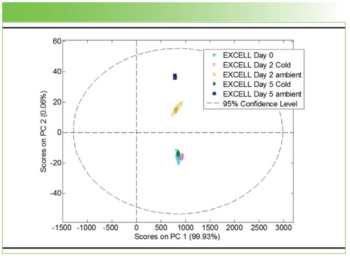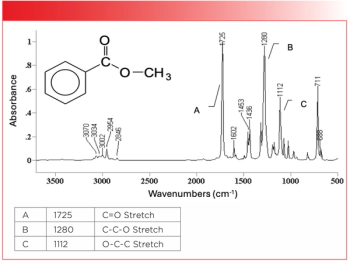Key Points
- Indian honey samples were analyzed for purity using near-infrared (NIR) spectroscopy and aquaphotomics.
- Water’s spectral behavior served as a sensitive probe for detecting adulterants.
- Six common adulterants were identified and quantified using chemometric models.
- The study demonstrates a fast, non-destructive method to assess honey authenticity.
Introduction: Shining Light on Honey Fraud
In a new study, Indian researchers have harnessed the power of light and water to detect fraud in honey, a product increasingly vulnerable to adulteration. The study, published in the Journal of Food Composition and Analysis by Nitin Kumar, K.K. Gupta, and P.C. Panchariya, explores how near-infrared (NIR) spectroscopy combined with aquaphotomics can uncover subtle changes in honey caused by the addition of sugar syrups and other sweeteners (1,2).
Their research not only presents a fast and non-destructive analytical method but also illustrates how water's spectral signature can serve as a sensitive indicator of chemical changes in food products.
Institutions and Authors Behind the Work
The study was conducted by researchers from the Department of Electronics and Communication Engineering, and P.C. Panchariya from the Department of Electrical Engineering, all based at Malaviya National Institute of Technology (MNIT), Jaipur, India. Their interdisciplinary work bridges food analysis, spectroscopy, and data science (1).
Using Light to Uncover Sweet Deception
The team applied NIR spectroscopy in the wavelength range of 900–1700 nm, targeting molecular vibrations that reveal detailed chemical information. But instead of only looking at typical sugar signatures, the researchers used aquaphotomics, a method that interprets the absorbance patterns of water molecules to sense the presence of other compounds.
Water, acting as a molecular mirror, changes its absorbance behavior depending on its interactions with dissolved substances. In adulterated honey, these subtle changes in water’s spectral profile become detectable (1).
To demonstrate this, the researchers prepared over 160 honey samples, including pure Indian honey and samples spiked with common adulterants such as glucose, fructose, sucrose, high-fructose corn syrup, maltose, and invert sugar (1).
Chemometrics: Decoding Complex Spectral Patterns
Spectral data alone is dense and difficult to interpret without computational tools. That’s where chemometrics—the application of mathematical and statistical techniques to chemical data—played a crucial role (1,2).
The team employed principal component analysis (PCA) and partial least squares discriminant analysis (PLS-DA) to classify honey samples and distinguish between pure and adulterated varieties. For quantification, they used partial least squares regression (PLSR) models (1).
The classification models achieved 100% accuracy in identifying pure versus adulterated honey, while the regression models showed high correlation coefficients (R² > 0.98) and low root mean square error values, indicating excellent predictive performance (1).
Water as a Diagnostic Medium
A key contribution of the study lies in the water matrix coordinates (WAMACs) identified through aquaphotomics. These spectral water absorbance bands act as sensitive fingerprints of adulteration. Changes in WAMACs reflect variations in the honey's composition, especially when adulterants alter the hydrogen bonding network of water (1).
By tracking these water-specific bands, the researchers could detect even minor levels of adulteration, making this approach uniquely powerful compared to conventional sugar profiling (1).
Toward Real-Time, Non-Destructive Honey Authentication
The combination of NIR spectroscopy, aquaphotomics, and chemometrics offers several advantages: no sample preparation, rapid analysis, and no destruction of the sample. This makes the method highly appealing for real-world applications such as on-site quality checks, regulatory screening, and commercial authentication (1).
Importantly, this technique can be extended beyond honey to monitor the authenticity of other food products where water plays a key role (1).
As honey continues to face threats from economically motivated adulteration, this study offers a demonstration that light and water, when analyzed thoughtfully, can expose hidden impurities (1). NIR techniques provide a promising tool to help protect the integrity of honey, one of our most cherished natural products (1,2).
References
(1) Kumar, N.; Gupta, K. K.; Panchariya, P. C. Qualitative and Quantitative Analysis of Indian Honey Samples and Various Adulterants Using Near Infrared Spectroscopy with Water as a Sensing Probe (Aquaphotomics) and Chemometrics. J. Food Compos. Anal. 2025, 144, 107735. DOI: 10.1016/j.jfca.2025.107735
(2) Miaw, C. S. W.; Rovira, G.; de Oliveira, L. L.; Andrade, M. V. O.; Callao, M. P.; Ruisánchez, I.; Sena, M. M.; de Souza, S. V. C. One-Class Modeling Methodology to Detect Adulteration in Brazilian Honey by Portable Near Infrared Spectroscopy Based on the Optimization of Performance Parameters. Microchem. J. 2025, 192, 113767. DOI: 10.1016/j.microc.2025.113767






